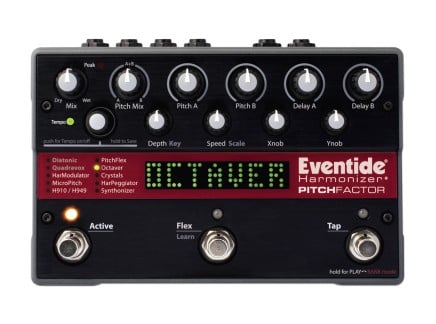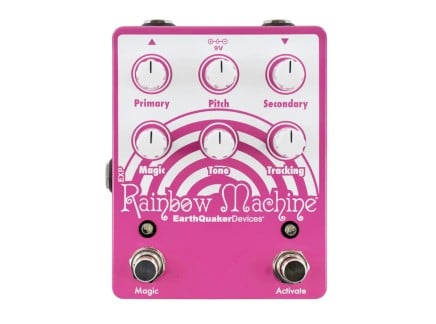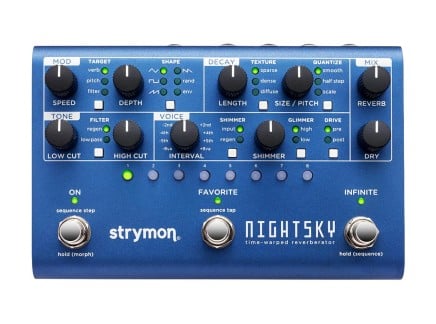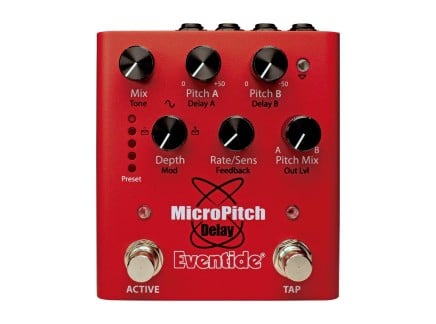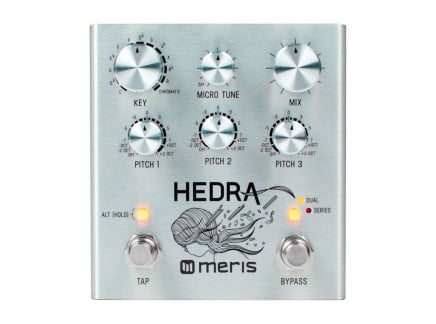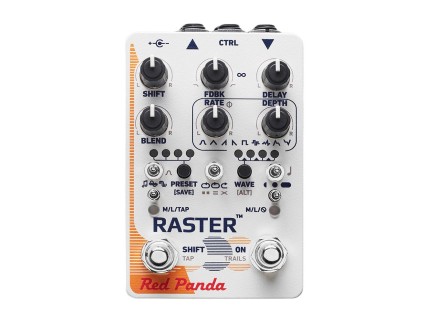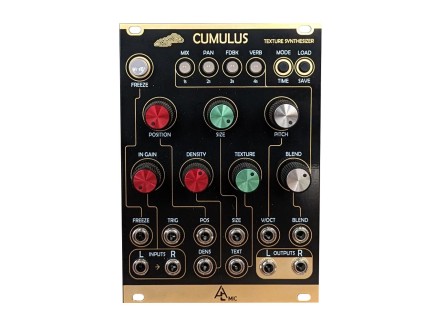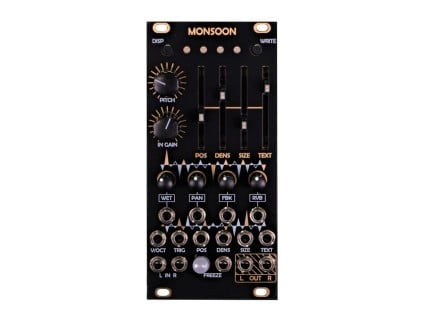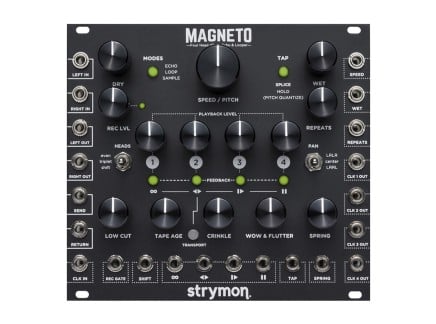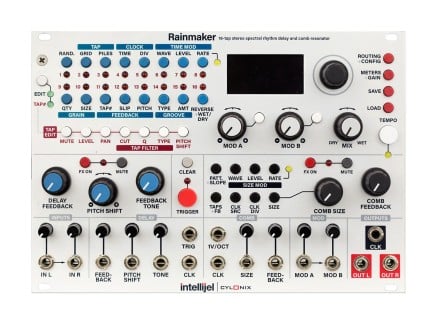Who doesn't love a good delay pedal? Whether purely digital, analog, or a warbly tape echo, this effect has been broadly adored by musicians since the dawn of its discovery. Using delay lines offers a wealth of sonic transformations ranging from subtle and utilitarian—as in compensating for the distance between the speakers at a large venue—to more pronounced sonic embellishments, allowing us to add a sense of space to the sound source on a recording.
Of course, they can be pushed even further: delay lines can also be useful for emulating sounds of acoustic instruments (as in Karplus-Strong synthesis), and can furthermore be taken to the extreme with high feedback and heavy modulation. It also wouldn't be an understatement to suggest that delaying sound is one of the most significant developments in audio signal processing, insofar that it serves as a building block for a variety of complex effects including filters, reverbs, and more.
No two delay effects are the same, and today we will be taking a deeper look at what can perhaps be considered as the weirdest, and the gnarliest of the bunch: pitch-shifting delays. Pitch shifting delays allow for the ability to shift the pitch of echoes, making for call-and-response type behavior with the input audio. Or, in the most extreme cases, pitch shifting delays can create effects where echoes continually shift upward or downward in pitch, creating smears of echo trails dripping off the original signal in all directions. Because the applications of pitch-shifting delays can vary dramatically, changing in an instant from the sweetest angelic choirs to swirling disorienting madness, we opted to take a deeper dive into where these effects came from and how they work. Thus with no further delay (pun intended), let's jump in.
Origins
Audio delays and pitch shifting are highly interconnected processes, both stemming from the early days of musicians and recording engineers' tape experiments. Feeding a signal from one tape machine to another would cause a delayed signal output. Changing the speed of the tape playhead would alter the pitch of the sound. While both effects were possible individually, there were a few caveats of working with tape.
For one, pitch shifting was strictly a post-recording process, impossible to achieve in real-time. Secondly, delay time and pitch were in many ways technologically intertwined: both were dependent on the speed setting of the tape machine. Thus, lowering the speed of the playhead would increase the delay time, and lower the pitch simultaneously. This limitation certainly inspired some very creative applications…but splitting processing between the time and frequency domains held a great set of useful and creative applications, and people were looking for a solution.
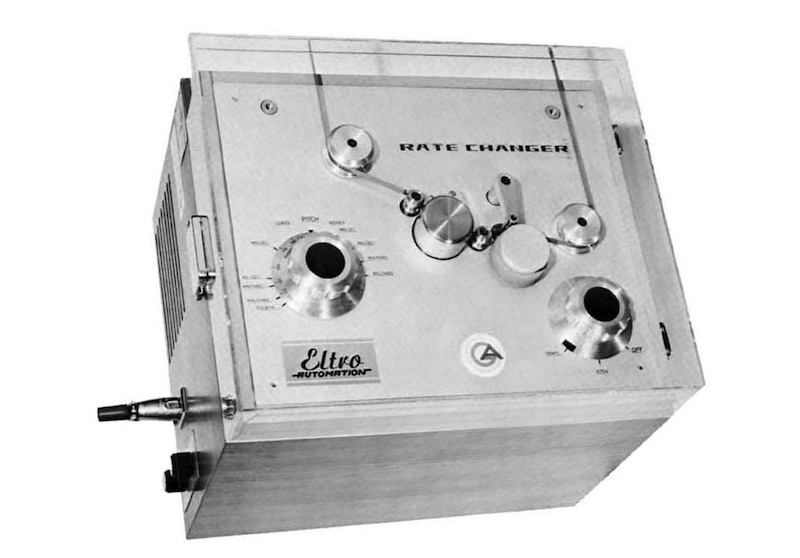
Before digital technology matured enough to offer any solution in that realm, special mechanical accessories were used, with the most well-known of all being the Eltro Information Rate Changer (or Tempophon, as it was known in some parts of the world). Developed by German engineer Anton Marian Springer, the Eltro was a rotating drum with four tape heads attached to it. Separate control over tape speed and drum rotation allowed for independent adjustment of pitch, and compression/expansion of the duration of the recording. Available starting in the early 50s, the Eltro became an increasingly popular tool in recording studios for two decades, and it played a crucial role in the realization of several iconic works such as the slowly degrading voice of computer Hal as it was being deactivated in Kubrick's science fiction classic 2001: A Space Odyssey (1968). However, by the mid-1970s, the world was steadily entering the new digital age, and technology was changing rapidly.
The next evolution of the concept came from the emerging brand Eventide Clockworks, who fully embraced the new era and integrated digital technologies in the products from the very start. After highly-acclaimed work creating digital delay processors, in 1975 Eventide presented to the world the H910 Harmonizer—a digital audio effects processor unlike anything else that was available at the time.
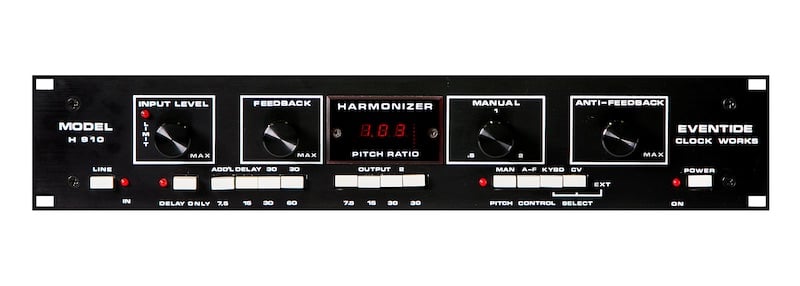
H910 combined an independent digital pitch-shifter capable of transposing a sound across 2 octaves, and a pair of delay lines with dedicated outputs and a feedback path. H910 quickly became one of the most in-demand studio tools, and without exaggeration, it has aided in shaping the sonic character on countless records since its release. H910 also set the vector for Eventide's development altogether, as over the years they perfected their vision of pitch-shifting delay effects to stunning results. With the release of H910, the company also coined the term "Harmonizer," which is still actively used to describe the effect. The H910 would eventually evolve into H949, H969, and then the H3000—a groundbreaking and trend-setting multi-effect processor whose influence can be seen all the way to the modern-day Eventide flagship H9000. (If you are curious about Eventide's history, check out our recent articles A Brief History of Eventide, Part 1 and A Brief History of Eventide, Part 2, where we get much deeper into their evolution across the decades.)
Soon after Eventide's groundbreaking contributions, various manufacturers jumped on the train—and different versions of pitch-shifting delays started to become available in a variety of formats. For example, in 1978 a French company called Pubilson released a quite remarkable sound processor called DHM89 B2. Although it wasn't nearly as popular as Eventide's devices, the DHM89 B2 was highly advanced for the time. It was optimized for stereo processing via two delay/pitch-shifter pairs with independent controls, and several unique features such as auto-arpeggio, auto-reverse, and per-channel memory latching (freezing audio in a memory buffer). Publison later also released the not-less-elusive Infernal Machine 90, officially described as a stereo audio computer that could do pitch-shifting delays, with features similar to DHM89 B2 plus some other delay and reverb-style effects.
The pitch-shifting delays from Eventide and Publison were nothing short of fantastic processors, so big studios and major artists eagerly added them to their setups. However, those devices were quite expensive, and at the time, a new and quickly-growing generation of budget studios relied on the availability of portable and inexpensive recording equipment. An early budget-friendly version of the pitch-shifting delay came from Roland's subsidiary Boss…one of the best-established pedal manufacturers in the world.
Around the mid-1980s Boss introduced the affordable Micro Studio series—a collection of eight half-rack format effects that were for the most part based on similar circuits as the brand's guitar pedals, often equipped with a few extra features meant to meet studios' needs. Among the series was the RPS-10 Digital Pitch Shifter/Delay. RPS-10 was equipped with five delay modes and three pitch-shifter modes with a range of two octaves (+1/-1). RPS-10 also excelled in routing options, with dedicated keyboard input for live control over pitch-shifter transposition, a footswitch input to turn the effect on and off, and a "Hold" footswitch input for engaging audio freeze. What is particularly interesting is that the "keyboard input" didn't expect a MIDI signal, but an audio signal—preferably a square wave in the range between C5 and C7. While that suggestion for the sound source and range was offered for optimal performance, it didn't mean that other kinds of audio signals could not be used, and a wealth of creative misuses presented itself: when sending particularly low or high input signals, the pitch shifting process becomes quite unpredictable and glitchy, as demonstrated beautifully in this YouTube video.

In 1987, Boss transported its concept of pitch-shifting delay into the guitar pedal realm with the release of PS-2—borrowing many of the RPS-10's features, but lacking the particularly interesting quirks like the hold footswitch option, audio tracking, and reverse delays. Instead, it focused primarily on clean digital delays, a manual pitch shift mode with fixed delay time, an octave up mode, and an octave down mode…each allowing for cascading shifted echoes. Subsequently, 1994's PS-3 expanded upon this idea considerably—including many more of the RPS-10's features, such as reverse delay modes (including the famed Mode 7, which provides reverse pitch shifted delay). It also features several dual pitch shift modes and stereo output…and to this day, it remains one of the most sought-after pedal-format pitch shifting delays altogether.
One more cost-effective classic versions of the pitch-shifting delay came from guitar-oriented Japanese brand Ibanez, who introduced their 1U rack size HD1000 Harmonics/Delay processor in 1983. HD1000 featured an odd +/- thirteen semitone transposition range, maximum delay between 126 milliseconds at full bandwidth and up to half a second at a reduced bandwidth, and a built-in modulation oscillator. The device was also equipped with an LCD screen providing live visual feedback for transposition, delay time settings, and input gain amount. And another great feature of HD1000 was the separate I/O for the feedback loop, allowing its users to expand the range of possible effects with external sound processors.
Of course, the devices listed above do not represent the full list of historical pitch-shifting delays, but some of the most important releases (and some of our personal favorites!) are certainly there. Essentially, once Eventide let the cat out of the bag with the H910, this effect became increasingly present in different formats, and occasionally as one or a few algorithms on multi-effects processors. For example, many of the programs on one of the weirdest pedals in history, DigiTech's XP-300 Space Station, were based on pitch-shifting delays.
Nuts and Bolts: The Anatomy of Pitch-shifting Delays
Now that we have covered some of the key historical inventions that led to the evolution of modern pitch-shifting delays, let's develop a deeper understanding of how they actually work. While audio signal delays can be produced in a variety of ways, for the purpose of this article we'll mainly focus on digital delays. In digital delays, an input signal is turned into a stream of numbers via an analog to digital converter which samples the audio at a specified rate and stores the values in a buffer of a specified size. Once the samples are in the buffer, they can be then played back following the specified parameter settings. Commonly, the delayed signal is also sent back into the input with a controllable amount—resulting in feedback, causing an echo-like effect. Both delayed and dry signals are then mixed and translated back into audio via a digital to analog converter. A crucial aspect of digital delays is their bit depth, as it significantly impacts the dynamic range and as follows the sonic character of the delayed signal. Thus, a digital delay with an 8-bit ADC has a limited dynamic range of 48dB, which means that there will be plenty of inconsistencies during amplitude-matching, which manifests as a very distinct digital noise added to the signal—a crunchiness of sorts that may offer just the right flavor in certain situations, and not so much in other use cases. Digital delays became available in the early 1970s, with Eventide's DDL 1745 being one of the first of its kind.
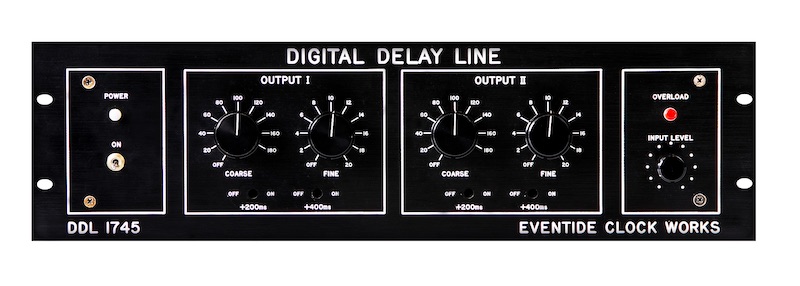
While pitch-shift-adjacent effects like ring modulation and frequency shifting can be created with all-analog circuitry, true pitch-shifting is a problem that is much better tackled in a digital domain. Gladly, understanding how a digital delay works in itself offers half of the solution.
If you recall, earlier in the article we talked about how the speed of tape playback directly affects the pitch of the sound—and things aren't terribly different in the digital realm. Thus, pitch-shifting occurs when the audio stored in the buffer is played back at a different rate than the one at which it was recorded. In older devices, the change of playback speed (and effectively pitch) was commonly done by direct alterations of the sample rate on the DAC, but these days, a method of interpolated reading from the storage buffer at a fixed sampling rate is used. While in present-day computing devices the size of the delay buffer is not an issue (one can easily delay a signal by hours if not days), early RAM (Random Access Memory) chips were highly limited, and delaying a signal was constricted to milliseconds. Plenty of interesting effects could be created even with that, however, short memory posed a certain problem for pitch-shifting. When the audio stored in a delay line buffer is played back at a different rate, it forces the delay line to either shrink or expand. This means that there is a memory-imposed threshold at which we either reach the maximum delay size or have to read into the future, which is clearly impossible. Thus, a clever solution to this came up where the signal is sent through two delay lines connected in series, and tied by a crossfade which smoothes out the looping area as the sound is transposed.
Because digital delay and pitch-shifting effects are principally based on the same technology, the fact that the two effects would be combined into a single "mega-effect" was unavoidable, and in fact, rather than thinking of them as two separate things combined, it is more useful to see them spread along a single gradient where one type of effect flows into/out of, and is dependent on the other. With moderately set parameters, pitch-shifting delays are great for artificially expanding the sound source, creating lush harmonies, as well as subtly animating the signal. Things change quite radically once feedback enters the equation. With higher feedback settings the effect starts to layer forming swarms of cascading pitch-shifts—all corresponding to the same pre-set interval, shifting progressively higher or lower with each repeat. Add to this a modulation over the pitch-shifting amount, and suddenly we have an arpeggiator-like effect.
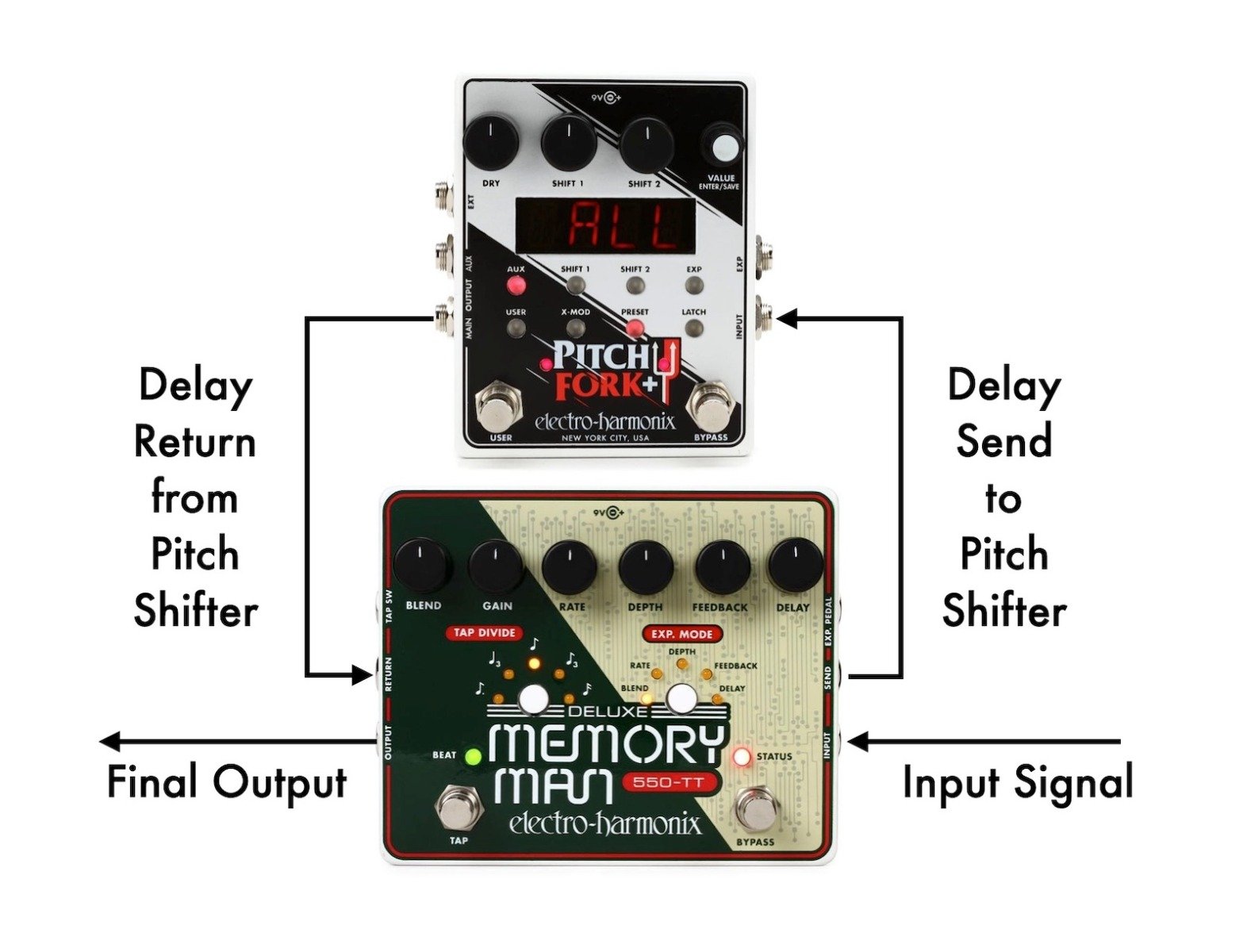
Of course, it's possible to create this effect using any analog delay, pitch shifter, and feedback. This is particularly easy with delay pedals that feature a built-in FX loop which allows you to insert additional effect processors in the delay's feedback loop. For instance, you can use an Electro-Harmonix Deluxe Memory Boy, Memory Man 550-TT, or Memory Man 1100-TT with any pitch shift pedal to create a particularly warm, soft variation of this effect.
But that said, it is important to note that over the years manufacturers have experimented with this effect quite a bit, and a variety of approaches has emerged for creating dedicated digital pitch shifting delays. Thus, it is not uncommon in modern devices to have separate delay and pitch shifting functions that are combined via a fixed or user-defined routing. Let's take a look at some of our favorites.
Pitch Shifting Delay Pedals
Guitarists embraced digital pitch-shifting delays early on. In fact, because of how popular H3000 became among guitar players, in 1995 Eventide released a dedicated version of the flagship multi-effects processor specifically for that audience: the GTR4000. With that said, it's no wonder that pitch-shifting delays are not an uncommon sight among the abundance of modern stompboxes. We have already mentioned some historical examples, such as DigiTech's XP-300 and the Boss PS-2—but now, let’s take a look at a few more modern pedals.
Of course, over the years Eventide has found a number of ways to put their widely loved pitch-shifting delay algorithms in a compact pedal format. Released in the late 2000s, PitchFactor was the first one, and it came not with just one effect, but with ten premium harmonizer algorithms, including cult hits like Quadravox, Crystals, and H910/949 emulations. Then in 2013, the company released the H9–perhaps one of the most compact multi-effects processors of such caliber. H9 Max features the complete set of 45 algorithms encompassing all of the effects found in the Factor series pedals with expanded control via a separate software app.
Finally, most recently the company expanded their family of pedal-format effects with the dot9 series, in which they took a different than usual approach by segmenting the effects into streamlined single-algorithm stompboxes. The selection process for the effects was heavily influenced by the popularity of the algorithms in different categories. As such, the MicroPitch algorithm was turned into a dedicated (micro) pitch-shifting delay pedal. With two independent delay lines up to 2 seconds in length, per-channel +/-50 semitones pitch-shiting, and a built-in filter for smoothing the tone, MicroPitch excels at organic stereo chorusing, widening, and lush delay effects, as well as less subtle comb-filtering and evolving psychedelic swells.
Conceivably one of the most well-known pitch-shifting delay stompboxes that certainly checks the "weird fx" box for many is the Rainbow Machine from Earthquaker Devices. Easily recognizable by its distinct bright pink look, Rainbow Machine's legendary status is well earned due to the immense range of effects it makes possible. Within a few knob twists, the pedal can morph between subtle to heavy detuning, clean harmonizing, stunning self-oscillating chorusing, deep flanging, textured and arpeggiating delays, wild feedback effects, and more. It also includes an expression pedal input, a momentary footswitch configuration, as well as a dedicated "Magic" switch for time-warped feedback…making it super interactive, and great to perform with. If you want something from the wilder side of pitch-shifting delays, this is one to look at.
Another brand that is doing a lot of great things in the realm of pitch-shifting delays is Red Panda—whose line of effects contains three very different approaches to pitch-shifting delay: Raster 2, Tensor, and Particle 2. Among the three, Raster 2 is the closest in design and principle to the types of pitch-shifting delay effects we've discussed here, of course with several unique features such as stereo processing, a large variety of internal modulation options, three delay routing options, and full MIDI compatibility. Although by no means the same, the effects made possible by the Raster are easily placed in a similar realm as those produced by Rainbow Machine and popular Eventide algorithms—all in stereo, with a high degree of customization options. Quite uniquely, Raster can be switched between frequency-shifting and pitch-shifting effects, and both can be routed before or after the feedback path with each option causing a drastically different output.

Tensor and Particle 2, on the other hand, offer an alternative perspective with a major focus on glitched-out sampling and granular synthesis, respectively. And although the latter two fall a bit outside of the classic pitch-shifting delay category, they do still offer a decent amount of overlap to be included here. After all, all of them interact with concepts of time-warping and pitch-shifting. Sound-wise, Tensor makes it quite easy to replicate the charming artifacts of technological malfunctions of chewed-up tape, skipping CDs, and other digital glitches. Particle, on the other hand, comes through with lush textures, shimmery effects, strange inharmonic tones, and much more.
Los Angeles-based effects wizards Meris also have not one, but three different pedals that relate to the category of our interest in this article: Hedra, Polymoon, and Mercury 7. All three pedals present very different approaches to pitch-shifting and delay effects, each one with more features and tricks that would be possible to list in this article.
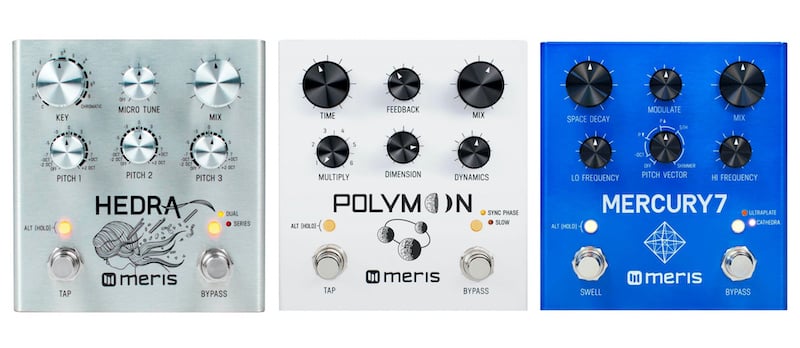
Hedra is described by the company as a rhythmic pitch shifter, sporting three separate pitch-shifting delay voices, with each delay line time interval tied to the main master tempo, and each pitch-shift interval tied to a global key parameter. With Hedra, it is easily possible to create complex harmonies, animated rhythmic arpeggios, intricate multitap delays, and so much more. And if sweet harmonies and melodies don't do it for you, with the "Microtune" parameter you can apply further pitch alterations ranging from subtle detune effects and chorusing to extreme cacophony (in the best possible way).
In the way that Hedra's set of parameters immediately makes you think that it is a sort of harmonizer pedal, Polymoon's control layout seems to make it seem like a straightforward delay. However, just like everything else that Meris does, it is not just a plain old cut-and-dried delay, but it is rather full of unique features such as a morphing low/highpass feedback filter, up to six delay taps organized in different combinations via the Multiply control, diffusion of delay taps via the Dimension control, dynamic flanging, phasing, and of course a variety of pitch-shifting effects ranging from mild chorusing all the way to strange modulated pitch effects.
Finally, Mercury 7 takes us somewhere where haven't gone yet in this article—the magical realm of pitch-shifting reverbs. Although some of that territory is covered with Polymoon once pitch-shifting is combined with high settings on the "Dimension" control, on Mercury 7 Meris puts this concept right at the core of the pedal's character. Inspired by the larger-than-life tones of Vangelis's Blade Runner score, Mercury 7 is endowed with two reverb algorithms—Plate and Cathedral—in combination with a set of fantastic features such as complex modulation matrix, a Swell switch for automatic volume fade-ins, and the Pitch Vector parameter, allowing for pitch-shifting in the reverb's feedback path. The control features 6 distinct states: Off, octave down, Slight pitch down, and up, fifth up, and shimmer (octave up). Mercury 7 also allows you to dial an amount for the added pitch-shifting effect, thus bringing even more nuance to the pedal's sonic capabilities. (It's worth noting—both Hedra and Mercury 7 are also available as 500 Series modules for studio effect processing!)
Continuing with the subject of pitch-shifting reverbs brings us to one of the recent releases from Strymon—the magnificent NightSky. Even a first glance at the NightSky suggests that it is likely not a simple set-and-forget type of reverb, but rather a complex and interactive sound processing machine. To navigate that level of complexity, Strymon cleverly broke down the interface of the pedal into five main sections: 'Mod' for modulation matrix, 'Decay' for crucial reverb settings, 'Tone' for filtering the sound, 'Voice' for pitch-shifting, resonance, and overdrive parameters, and lastly 'Mix' for blending the dry, and the processed sounds. Additionally, the pedal includes a dedicated switch for engaging infinite sustain mode, and an eight-step sequencer for modulating the pitch interval, which renders NightSky not only as an effect pedal, but an instrument in itself.
Although we can't list all the pitch-shifting delay pedals within the scope of this article, before we go on to the next section, we would like to mention that there are also a few multi-fx pedals that offer comprehensive pitch-shifting delay algorithms. The list includes such hit pedals as Source Audio's Nemesis, Strymon Timeline, and the Empress Echosystem.
Pitch Shifting Delay Eurorack Modules
Modulation of different parameters has long been an essential element in many pitch-shifting delay devices, and what better platform for this than a modular synthesizer—specifically the Eurorack format, which offers a seemingly unlimited number of options for reconfiguration. Quite a few manufacturers have seized the opportunity and created some of the most exciting harmonizing delays so far.
Make Noise is one of the brands that spearheaded the modern evolution of Eurorack synthesizers.—and they have explored the possibilities of pitch-shifting delays in a synthesizer format since the early years of their existence. In 2012, the company released Echophon, a pitch-shifting delay module created in collaboration with Tom Erbe of Soundhack. It was largely inspired by the Eltro Tempofon (mentioned earlier in this article). While Echophon was ready to deliver familiar pitch-shifting effects, it was more than that: it was designed in a way that offered the user to decide some major aspects about the routing, and consequently the sound. Instead of having built-in modulation, Echophon sported control voltage inputs for all of its parameters, allowing the user to decide on the modulation sources. It also offered a dedicated clock output, and an open feedback path.
Without a doubt, one of the most influential Eurorack modules created in the last 15 years was the Mutable Instruments Clouds Texture Synthesizer. Thus, once Mutable finally announced the release of its successor, Beads, a wave of excitement crossed the synth community, and for good reason. Clouds has remained one of the most exciting effect modules in Eurorack altogether, with a strong character and a wealth of features and secret modes. Beads is built around the same framework of granular delay/pitch shifting, but with major improvements in functionality and sonic quality. A particularly welcome update in Beads' design is a streamlined interface that doesn't require pressing button-combos to access some crucial parameters like reverb amount and feedback, but of course there is much more to Beads. Regrettably, with Mutable Instruments closing its doors in 2022, production has also ceased entirely for Beads—but Clouds is still alive and well in the form of many cloned alternatives, including devices that expand considerably on its original layout and functionality. After Later Audio's Cumulus, for instance, is a 1:1 reinvention of the original Clouds module, while their Monsoon offers all the same functionality and more, with a smaller yet significantly expander user interface and I/O scheme.
Some companies manage to explore both stompbox and Eurorack domains, often offering the same core devices in both formats, of course with certain differences. One of such companies is Strymon, who entered the Eurorack market a few years ago with Magneto—a stunning tape-echo-inspired multi-tap delay with pitch-shifting and sampling capabilities. Being a huge success, many elements from Magneto were later used by Strymon in the design of the Volante pedal. Most recently the company introduced their second Eurorack module StarLab, which follows a similar layout as Magneto, but feature and sound-wise it is directly based on the aforementioned NightSky pedal. If NightSky itself contained a decent amount of built-in modulation options, StarLab is expanded in that regard, making even the parameters of the internal LFO freely modulate-able.
Delay modules in Eurorack are getting more and more complex, and as you can see there are plenty of options for wild pitch-shifting effects too, but perhaps to this day one of the densest and most intricately programmable delay/pitch-shifter modules remains the Intellijel Rainmaker. With 16 individually programmable delay taps of rhythmic delay section, a separate comb filter, flexible routing options, randomization modes, and CV inputs for the majority of its parameters—Rainmaker is an absolute unit that makes it possible to design any kind of delay/pitch-shifter effect. It may not be immediately accessible, and getting a hang of its full potential may take some time, but once you feel comfortable with the module, it becomes a playground for creative effects.
Shifting Gears
While we have tried to pack as much information about pitch-shifting delay effects as possible, it is highly likely that we may have forgotten something or someone along the way. Nevertheless, the goal here was largely to share our fascination with that powerful method of audio processing, and hopefully inspire some of your own explorations in that realm. Until next time!





